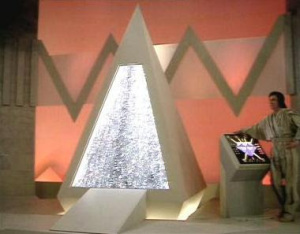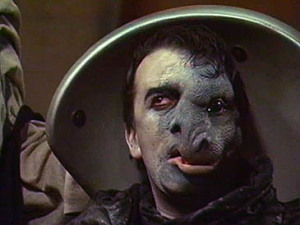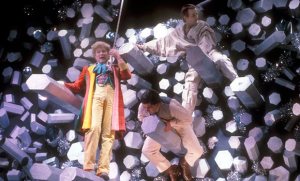Program Note: Apologies to my loyal reader(s) for the lapse in this series. The past few weeks have had various sorts of busy-ness about them. And now, on with the post:
 The Story
The Story
The planet Karfel is ruled by a tyrant known as the Borad, who never shows himself except on a video screen and rules through a council led by the Maylin (something like a prime minister). Enforcing his rule through the actions of both human and android guards, the Borad has anyone who resists either executed or thrown into the “Timelash”— a time corridor leading to some unknown point in space and time from which no one ever returns. While in flight, the TARDIS intercepts the Timelash, which actually goes to Earth in the eleventh century, causing its latest victim to arrive in the 1800s instead. Concerned he’s disrupted someone’s travel, the Doctor takes the TARDIS to help and soon picks up the young noblewoman last thrown into the Timelash, along with a young HG Wells, and the whole party heads back to Karfel for a confrontation with the evil Borad.
Review
Timelash is the episode you’re supposed to hate if you’re a Dr Who fan. It’s almost proverbial in discussions of Classic Who that it’s the one you hope a non-fan does not come across when he finally listens to you telling him how great the series is. At the same time, though, it doesn’t often make people’s lists of the very worst episodes ever. It’s certainly a mediocre story from a very weak season, and it doesn’t do itself any favors with the tinfoil-filled booth that’s supposed to be the deadly Timelash (above). Like a lot of stories this season it seems to wander around for a while without quite going anywhere until it finally ends just because it’s filled up the airtime.
 On the other hand, it has its strengths. Paul Darrow, playing the villainous Maylin Tekker, twirls his metaphorical mustache in exactly the sort of way that would be awful in a serious drama but works in Dr Who’s melodramatic grandiose universe. Meanwhile Robert Ashby as the Borad gives the character the sort of soft-spoken menace that is often more scary than the bluster of the more obvious villain, and the makeup job— the Borad is revealed to be a scientist whose experiments with a mutagenic gas caused him to merge with a dinosaur-like creature native to the planet— is above average for the series. There is a decently suspenseful section when the Doctor and the rebels are trapped in the control room, under siege by the guards, and the Doctor gets to show some real cleverness by quickly building a time projector that shows his image several seconds out of synch with where he really is, allowing him to dodge the guards’ rayguns as they shoot at where he was rather than where he is.
On the other hand, it has its strengths. Paul Darrow, playing the villainous Maylin Tekker, twirls his metaphorical mustache in exactly the sort of way that would be awful in a serious drama but works in Dr Who’s melodramatic grandiose universe. Meanwhile Robert Ashby as the Borad gives the character the sort of soft-spoken menace that is often more scary than the bluster of the more obvious villain, and the makeup job— the Borad is revealed to be a scientist whose experiments with a mutagenic gas caused him to merge with a dinosaur-like creature native to the planet— is above average for the series. There is a decently suspenseful section when the Doctor and the rebels are trapped in the control room, under siege by the guards, and the Doctor gets to show some real cleverness by quickly building a time projector that shows his image several seconds out of synch with where he really is, allowing him to dodge the guards’ rayguns as they shoot at where he was rather than where he is.
 On the other hand again, the Doctor builds his time projector by grabbing some crystals from inside the Timelash itself, and while the story labors mightily to make his descent on a rope into the time corridor into a dangerous adventure, the set design again fails to do the story any favors. Meanwhile, the HG Wells character is just annoying. The writer had read a biography of Wells and discovered that, although he was an outspoken atheist later in life, as a young man Wells dabbled in spiritualism, and so he thought it would be an amusing twist to have Wells meet the Doctor at that stage of his life, and therefore mistake him for an evil spirit. While some comedy results, the character is so far away from the HG Wells who eventually became famous that it largely removes the point of introducing him at all (not to mention that he wanders through the entire episode taking notes on random bits of overheard dialog that seem to inspire all his later novels— thus suggesting that the message here is HG Wells never had an actual original thought). Finally, the Bandrils, an alien race the Borad has deliberately provoked into a way with Karfel, are sock puppets. Even keeping their appearances limited to communications by viewscreen doesn’t help hide the fact.
On the other hand again, the Doctor builds his time projector by grabbing some crystals from inside the Timelash itself, and while the story labors mightily to make his descent on a rope into the time corridor into a dangerous adventure, the set design again fails to do the story any favors. Meanwhile, the HG Wells character is just annoying. The writer had read a biography of Wells and discovered that, although he was an outspoken atheist later in life, as a young man Wells dabbled in spiritualism, and so he thought it would be an amusing twist to have Wells meet the Doctor at that stage of his life, and therefore mistake him for an evil spirit. While some comedy results, the character is so far away from the HG Wells who eventually became famous that it largely removes the point of introducing him at all (not to mention that he wanders through the entire episode taking notes on random bits of overheard dialog that seem to inspire all his later novels— thus suggesting that the message here is HG Wells never had an actual original thought). Finally, the Bandrils, an alien race the Borad has deliberately provoked into a way with Karfel, are sock puppets. Even keeping their appearances limited to communications by viewscreen doesn’t help hide the fact.
On balance: no, Timelash is not good. But neither is it the worst of the worst. It fits neatly into Classic Dr Who’s weakest era, and certainly I’d never pick it to show an interested non-fan— but then I’d hardly pick anything from the Sixth Doctor’s era to show a non-fan, unless it was a case of wanting to make sure they saw every Doctor (and in that case I’d pick The Two Doctors or Vengeance on Varos).
Details
- At the end of the story the Borad is thrown into the Timelash, and there are several points to note about that. First, it comes after he’s been overthrown and is no longer a real threat, and the Doctor hounds him into the Timelash by playing on his horror at his own deformed state. While it’s a clever insight of the Doctor to see through the bluster of the Borad’s pretense that the accident turned him into a superior life form, and if it was necessary in order to overthrow him might have been worth it to exploit, it comes across as needlessly cruel of the Doctor to stalk down an already-defeated, weeping figure shouting “Nobody loves you, Borad, nobody will miss you, nobody cares!” It’s part and parcel of the Doctor’s far more abrasive— and often violent— persona this season, and perhaps the least palatable example of it.
- Second, after the Borad is thrown back to Earth in the eleventh century, the Doctor determines that the time corridor emerged near Loch Ness and implies the Borad will become the source of legends about the Loch Ness monster. Well, let’s see. In Terror of the Zygons we met a giant aquatic dinosaur living in Loch Ness. Now we learn of a human with a deformed face living near the loch. Which is more likely to be the actual source of Loch Ness monster sightings?
- It’s revealed during the episode that the Doctor had visited Karfel once before, saving the planet from some trouble we never get to hear details about. The Third Doctor, Jo Grant, an an unnamed additional companion were involved in the adventure— which is interesting because the Third Doctor never traveled in the TARDIS (that we saw) with anyone but Jo and, later, Sarah Jane Smith. To date, none of the “lost adventures” novels written about past Doctors have thought to show us the Doctor’s previous visit to Karfel, although one of them did mention in passing that it was Mike Yates, of the UNIT days, who joined the Doctor and Jo on this unseen adventure. Since these tie-in novels have been firmly rejected as non-canonical by the new series, the question of who actually joined the Doctor and Jo for this adventure remains open.
Next Week:
“Revelation of the Daleks,” 2 episodes, the season 22 finale.

